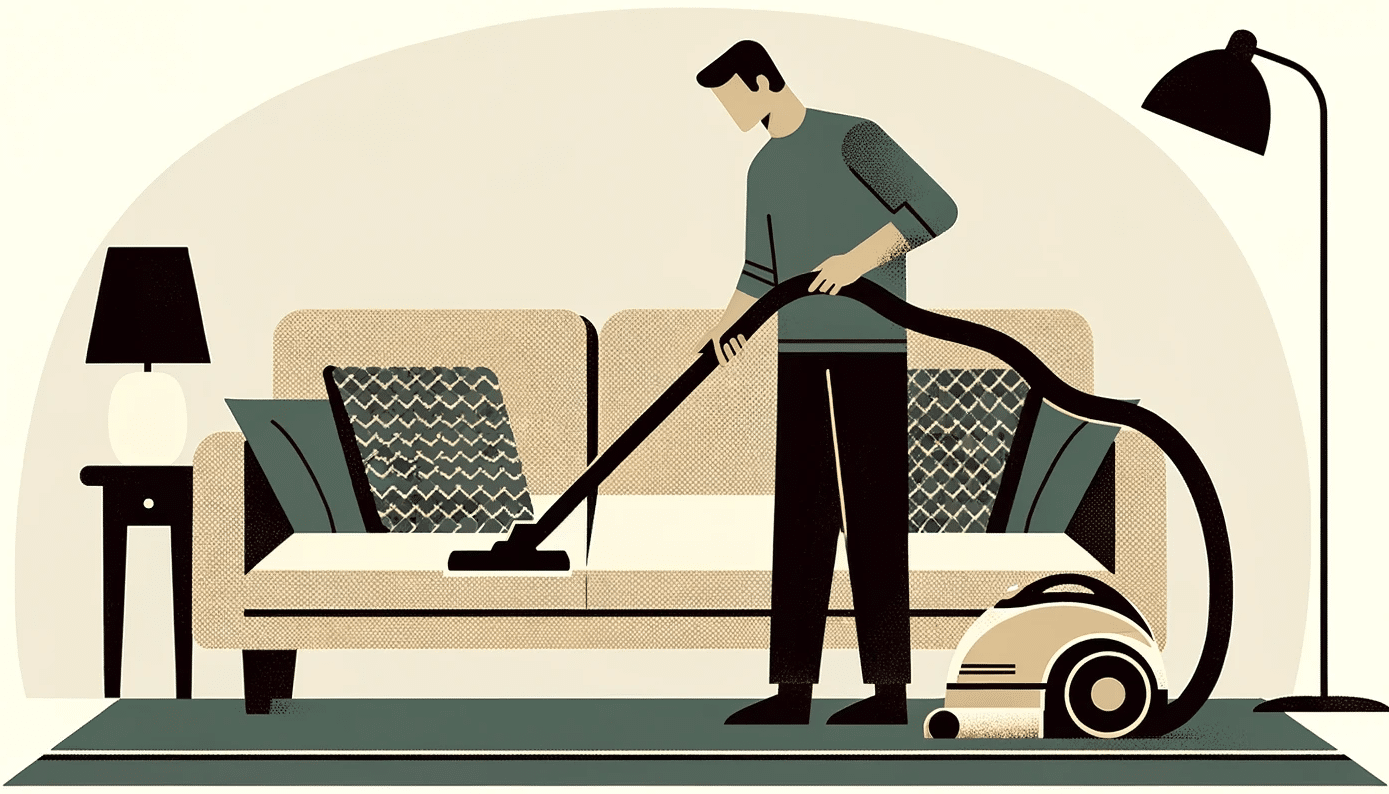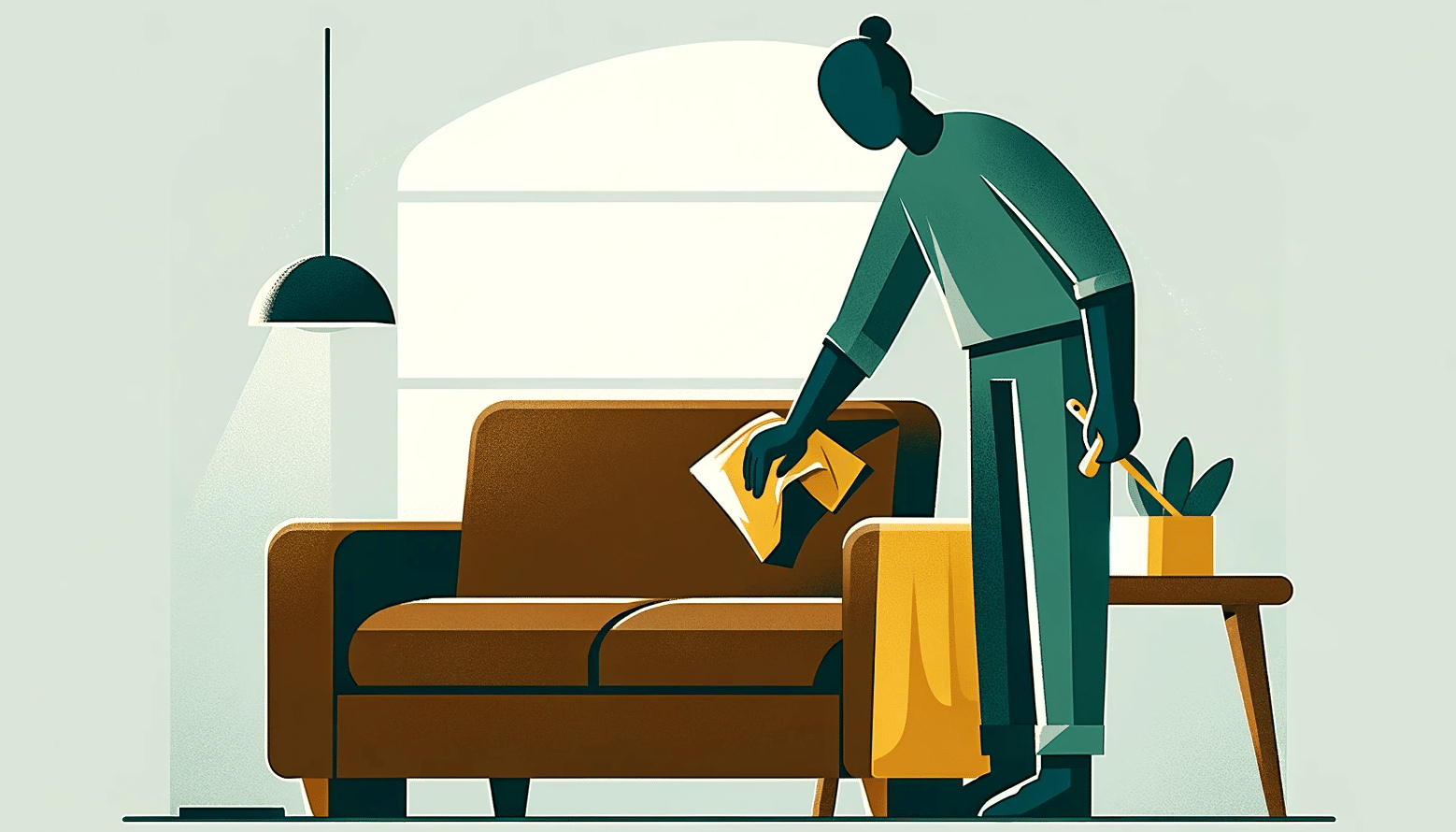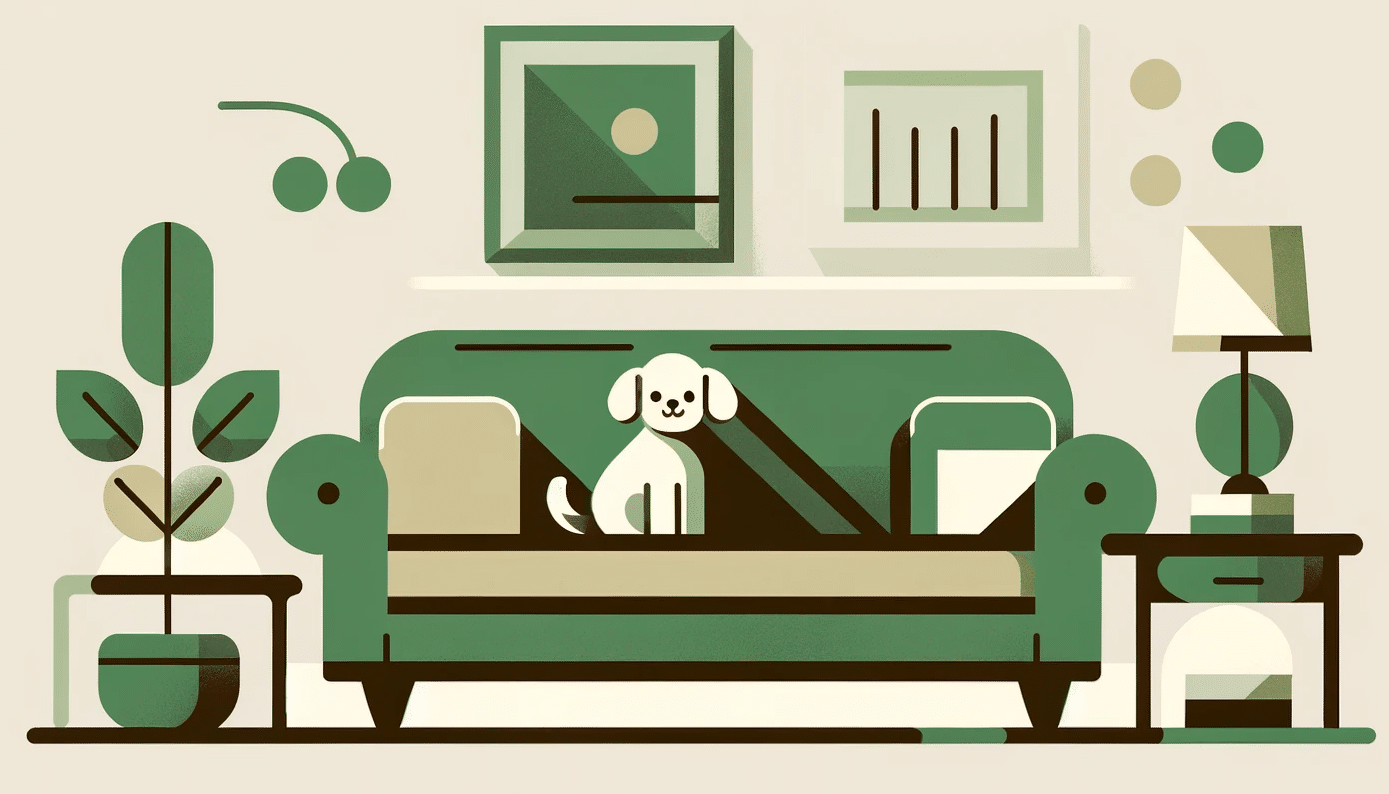Table of Contents
- Cheat Sheet on Cleaning Couch Cushions
- Understanding Your Couch Cushion Material
- Pre-Cleaning Steps
- Cleaning Techniques for Different Materials
- Dealing with Common Stains
- Drying and Maintenance Tips
- DIY Natural Cleaning Solutions
- Conclusion
Cheat Sheet on Cleaning Couch Cushions
Couch cushions, the comfort centers of our living rooms, often fall victim to neglect when it comes to cleaning. Yet, keeping them fresh is not as time-consuming as you might think. Here’s a quick, hassle-free guide to cleaning your couch cushions, even if you’re not up for a full cleaning session.
- Identify Your Cushion Material: Start by figuring out what your cushions are made of. Common materials include leather, fabric (such as cotton or linen), velvet, or microfiber. The cleaning method depends heavily on the material, so don’t skip this step!
- Quick Vacuum: Even if you’re not doing a deep clean, regularly vacuuming your cushions can make a world of difference. Use the upholstery attachment of your vacuum cleaner to get rid of surface dust, crumbs, and pet hair.
- Spot Cleaning: Noticed a recent spill or spot? Address it quickly! Use a mild cleaning solution – either a store-bought upholstery cleaner or a mild dish soap solution (for most fabric cushions). Apply it to the spot, gently dab with a cloth, and then wipe clean.
- Dealing with Odors: If your cushions are starting to smell, sprinkle some baking soda over them, let it sit for about 15 minutes, and then vacuum it up. This is a quick way to freshen up your cushions without water or cleaners.
- Wipe Down Leather: For leather cushions, a quick wipe with a damp cloth can remove surface dirt and maintain the leather’s quality. Avoid using too much water and don’t forget to dry the leather with a soft cloth.
- Freshen Up: A fabric freshener can do wonders in between washes. Just give your cushions a quick spritz and let them air out.
- Fluff and Rotate: Regularly fluff and rotate your cushions. This isn’t just about cleaning, but it helps maintain their shape and comfort level.
- Sunlight: If possible, let your cushions sit in the sunlight for an hour or two. Sunlight is a natural disinfectant and can help eliminate bacteria and odors.
This quick guide won’t replace a thorough clean, but it’ll keep your cushions in better shape between deep cleaning sessions.
Understanding Your Couch Cushion Material
Knowing what your couch cushions are made of is crucial for effective cleaning. The material not only dictates the cleaning methods but also the type of cleaning solutions you should use. Here are the most common types:

- Fabric: This includes cotton, linen, and synthetic blends. Fabric cushions are common and relatively easy to clean. They often come with removable covers, making washing simpler.
- Leather: Leather cushions require special care. They should be cleaned with products designed for leather to prevent cracking or fading.
- Velvet: Velvet, particularly if it’s a high-quality material like silk velvet, needs gentle handling. Avoid water-based cleaning methods as they can damage the fabric.
- Microfiber: Known for its durability and stain resistance, microfiber is often a preferred choice for families with kids or pets.
To identify your cushion material, check the care label usually attached to the cushion or underneath the couch. The label provides valuable information, including the fabric type and cleaning instructions (often indicated by specific cleaning codes). If you’re unsure or the label is missing, consider consulting a professional before proceeding with cleaning.
Pre-Cleaning Steps
Before diving into the actual cleaning process, a few preparatory steps are essential to ensure effective and safe cleaning of your couch cushions. These steps will help you avoid potential damage and make the cleaning process more efficient.

Remove the Cushions
If possible, take the cushions off the couch. This allows you to clean all sides effectively and reach areas that are usually hidden.
Vacuum Thoroughly
Using the upholstery attachment of your vacuum, go over each cushion thoroughly. Pay special attention to crevices where dust and crumbs tend to accumulate. This step removes surface dirt and debris, making the subsequent cleaning more effective.
Spot Testing Cleaning Solutions
Before applying any cleaning solution to your cushions, it’s crucial to do a spot test. Choose an inconspicuous area on the cushion and apply a small amount of the cleaner. Wait for a few minutes to ensure there is no adverse reaction, like discoloration or fabric damage.
Check for and Remove Any Solid Debris
In addition to vacuuming, check for any solid debris or objects that might be hidden in the crevices of the cushions. Removing these items prevents them from causing any damage during the cleaning process.
By following these pre-cleaning steps, you ensure that the actual cleaning process is as effective and safe as possible for your couch cushions.
Cleaning Techniques for Different Materials
Each type of cushion material requires a specific approach to cleaning. Below, we’ll cover the most effective methods for the common materials we identified earlier.

Fabric Cushions
- Machine Washable Covers: If your fabric cushion covers are machine washable, remove them and wash according to the care label instructions. Use a gentle detergent and opt for a mild cycle.
- Hand Washing: For non-removable fabric covers, create a solution of warm water and mild detergent. Use a soft brush or cloth to gently scrub the surface. Rinse with a damp cloth and avoid soaking the cushion.
- Steam Cleaning: Steam cleaning is effective for deep-set dirt and stains. Be cautious with the amount of moisture, as too much can lead to mold growth inside the cushion.
Leather Cushions
- Gentle Cleaning Solution: Mix a few drops of mild dish soap with distilled water. Dip a soft cloth into the solution, wring it out, and gently wipe the leather surface.
- Conditioning: After cleaning, apply a leather conditioner to keep the leather supple and prevent cracking.
Velvet Cushions
- Dry Cleaning: For most velvet cushions, especially silk velvet, dry cleaning is the safest option.
- Gentle Brushing: If the fabric is durable, lightly brush the surface with a soft-bristled brush to remove dust and maintain the fabric’s sheen.
Microfiber Cushions
- Rubbing Alcohol: Spray rubbing alcohol on the stained or dirty areas and gently scrub with a white sponge or brush to avoid color transfer. Let the alcohol evaporate.
- Brushing: Once dry, use a soft brush to fluff up the fabric.
By understanding and applying these material-specific cleaning techniques, you can ensure that your couch cushions are not only clean but also well-maintained, prolonging their life and appearance.
Dealing with Common Stains
Stains on couch cushions are inevitable, but they don’t have to be permanent. Here’s how to tackle some of the most common types of stains, from food spills to pet accidents.

Food and Drink Spills
- Blot Immediately: As soon as a spill occurs, blot it with a clean, dry cloth. Avoid rubbing, as this can push the stain deeper into the fabric.
- Mild Detergent: Use a solution of water and mild detergent to treat the area. Apply it gently, then blot dry.
Ink Stains
- Rubbing Alcohol or Hairspray: Apply a small amount of rubbing alcohol or hairspray onto a cloth and gently dab the ink stain. This method works well for microfiber and fabric cushions.
- Rinse and Dry: After treating the stain, rinse the area with a damp cloth and dry it thoroughly.
Pet Stains
- Enzymatic Cleaner: For pet urine or other biological stains, an enzymatic cleaner is effective. It breaks down the stain and eliminates odor.
- Prompt Cleaning: Address these stains as quickly as possible to prevent them from setting.
Oil and Grease Stains
- Baking Soda: Sprinkle baking soda on the stain and let it sit for 15-20 minutes. Vacuum it up, then clean the area with a mild detergent solution.
- Leather Cushions: For leather, a dry cloth should be used to absorb as much oil as possible before using a leather cleaner.
With these targeted methods, you can effectively handle most common stains, keeping your couch cushions looking fresh and clean.
Drying and Maintenance Tips
Proper drying and regular maintenance are crucial for preserving the life and appearance of your couch cushions. Here are some essential tips:

Drying Tips
- Air Dry: Always allow cushions to air dry. Avoid direct sunlight which can fade fabric, but ensure they’re in a well-ventilated area to prevent mold and mildew growth.
- Avoid Heat Sources: Don’t use a hairdryer or place cushions near radiators or heaters, as this can damage the fabric or filling material.
- Patience is Key: Give cushions enough time to dry completely. This may take several hours or even a full day, depending on the cushion material and thickness.
Regular Maintenance
- Vacuum Regularly: Vacuum your cushions weekly to prevent dust and dirt accumulation. Use the upholstery attachment for the best results.
- Rotate and Fluff: Regularly rotate and fluff your cushions to maintain their shape and even out wear.
- Protect from Sunlight: Prolonged exposure to sunlight can fade fabric, so try to position your couch away from direct sunlight, or use window treatments to mitigate exposure.
- Immediate Attention to Spills: Quickly addressing spills can prevent the formation of stubborn stains.
By following these drying and maintenance tips, your couch cushions will not only look better but also last longer, providing comfort and beauty in your living space for years to come.
DIY Natural Cleaning Solutions
For those who prefer environmentally friendly and cost-effective cleaning solutions, here are some simple DIY recipes you can create at home. These natural cleaners are gentle on most fabrics and effective against common stains and odors.
Simple DIY Upholstery Cleaner
- Ingredients: Mix ¼ cup of vinegar, ¾ cup of warm water, and 1 tablespoon of dish soap.
- Application: Spray the solution onto the stain, let it sit for a few minutes, then gently blot with a clean cloth. Rinse with a damp cloth and air dry.
Baking Soda Odor Absorber
- Use: Sprinkle baking soda over the cushion and let it sit for 15-20 minutes. Vacuum it up to remove odors and freshen up the fabric.
Vinegar and Olive Oil for Leather
- Mixture: Combine ½ cup of olive oil with ¼ cup of vinegar in a spray bottle.
- Usage: Spray the solution onto a soft cloth and gently rub it onto leather cushions. This not only cleans but also conditions the leather.
Lemon and Salt for Tough Stains
- Combination: Make a paste with lemon juice and salt.
- Application: Apply the paste to stubborn stains, especially on lighter fabrics, and let it sit for a few minutes before rinsing off.
Conclusion
To conclude, regular cleaning and maintenance of couch cushions are essential for extending their lifespan and keeping them looking as good as new. Whether you opt for commercial cleaning products or DIY solutions, the key is understanding the material of your cushions and treating them accordingly. By following the tips and techniques outlined in this guide, you can tackle everything from routine cleaning to stubborn stains, ensuring that your couch remains a comfortable and inviting centerpiece in your home.
